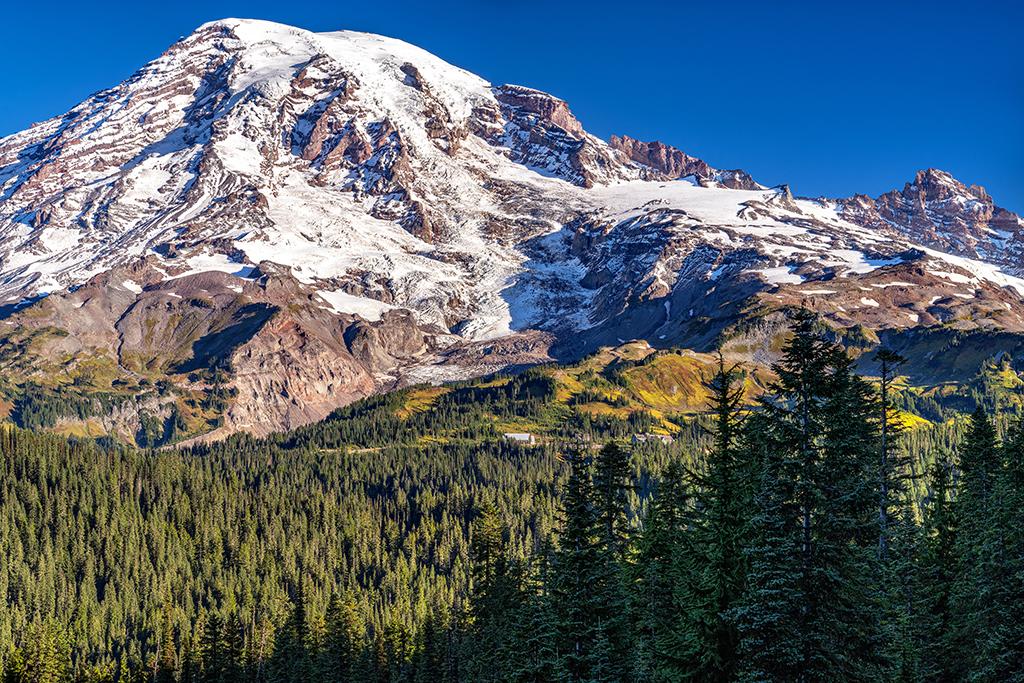
A distant view of the Paradise Area from the Pinnacle Peak Trail, Mount Rainier National Park / Rebecca Latson
On a clear sunny day in the Seattle/Tacoma area of Washington State, the locals often remark “The Mountain is out.” Gaze eastward and you, too, will see The Mountain, a 14,410-foot-tall (4,392 meters) volcano towering over the landscape in all its glacier-flanked glory. It’s a sight to behold. It’s also the centerpiece of Mount Rainier National Park.
Before European explorers ever set eyes upon this icon of the Pacific Northwest, the Cowlitz, Muckleshoot, Nisqually, Puyallup, Squaxin Island, Yakama, and Coast Salish peoples revered the mountain, calling it by various names: Tahoma, Takhoma, Tacoma, Ta-co-bet, Taqo ma, Tkobed, Taqo bid, Tkomen, Nutselip, and Pshwawanoapami-tahoma.
Born of fire and sculpted by ice, this episodically active volcano boasts the most glaciers on a mountain within the contiguous United States. Twenty-five major glaciers have a combined area of 35 square miles (90 square kilometers), covering almost 10 percent of the park.
There are five entrances from which to gain access to the many trails and scenic views. Nisqually, Stevens Canyon, and Sunrise are the most popular portals, and Nisqually Entrance is the only one open year-round (weather permitting).
Five areas are accessible via one or more of these five entrances:
Paradise - the most-visited area within the park and home to Paradise Inn.
Sunrise - the highest point that can be reached by vehicle
Longmire - designated a National Historic District and location of the National Park Inn
Ohanapecosh - located among old-growth forest
Carbon River-Mowich – a landscape of old-growth forest and inland temperate rain forest, shaped by volcanic activity and glaciation, including the Carbon Glacier, which has the lowest terminus of any glacier in the contiguous United States.
A surfeit of hiking trails for any skill level may be found in the park’s three life zones (forest, subalpine, alpine). Most trails offer some view of Mount Rainier while other trails highlight waterfalls, wildflower-blanketed meadows, the cool green solitude of mossy forest interiors, glacially-sculpted landforms, and overlooks with views of the vast landscape around and beyond. If you have the stamina and the time, you can even tackle the 93-mile (150-kilometer) Wonderland Trail encircling the entire park.
In addition to day hikes and backcountry trails, the park is a magnet for climbers intent upon ascending this glacier-iced volcano. The park roads are open to bicyclists and there’s even a 154-mile (247.8-kilometer) RAMROD (Ride Around Mount Rainier in One Day) annual bike ride organized by the Redmond Cycling Club. For those of you who want to see the park from a waterier perspective, kayaking and canoeing are allowed on most of the park’s lakes.
Even during winter, when all roads except for the Nisqually Entrance road are closed for the season, there are still plenty of outdoor activities from snowboarding, to snowshoeing, to cross-country skiing, and a little downhill skiing at Paradise.
Pack your binoculars and camera to observe the park’s abundance of wildlife. You might spot black bears, elk, foxes, deer, squirrels, marmots, and mountain goats. If you are a birder, you’ll definitely see (or hear) one or more of 182 bird species living within or migrating through the park, including Steller’s jay, Canada jay, grouse, American dippers, and dark-eyed juncos.
Visit during mid-July through early August and your eyes will feast upon wildflowers such as avalanche lilies, glacier lilies, lupine, and scarlet paintbrush blanketing the meadows at both Paradise and Sunrise areas.
A day of exploration at this national park is not really enough, so you might feel like overnighting at either Paradise Inn or National Park Inn, both lodging choices in-park. If you feel like pitching a tent or parking your RV directly beneath the starry sky, you can do so at one of the park’s four campgrounds.
With so much to see, do, and photograph at Mount Rainier National Park, you might wonder where to start first. This Traveler’s Checklist should help you with your planning.
Traveler’s Choice For: Hiking, photography, climbing, birdwatching, geology, winter activities




 Support Essential Coverage of Essential Places
Support Essential Coverage of Essential Places






